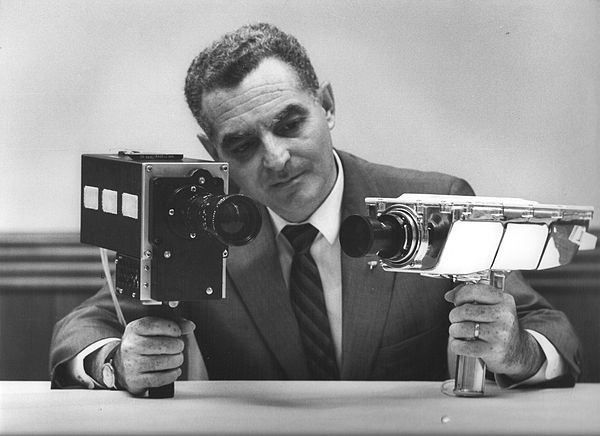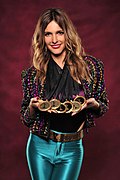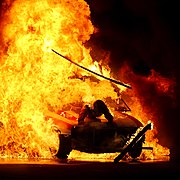Portal:Television
The Television Portal

Television (TV) is a telecommunication medium for transmitting moving images and sound. Additionally, the term can refer to a physical television set, rather than the medium of transmission. Television is a mass medium for advertising, entertainment, news, and sports. The medium is capable of more than "radio broadcasting", which refers to an audio signal sent to radio receivers.
Television became available in crude experimental forms in the 1920s, but only after several years of further development was the new technology marketed to consumers. After World War II, an improved form of black-and-white television broadcasting became popular in the United Kingdom and the United States, and television sets became commonplace in homes, businesses, and institutions. During the 1950s, television was the primary medium for influencing public opinion. In the mid-1960s, color broadcasting was introduced in the U.S. and most other developed countries.
In 2013, 79% of the world's households owned a television set. The replacement of earlier cathode-ray tube (CRT) screen displays with compact, energy-efficient, flat-panel alternative technologies such as LCDs (both fluorescent-backlit and LED), OLED displays, and plasma displays was a hardware revolution that began with computer monitors in the late 1990s. Most television sets sold in the 2000s were flat-panel, mainly LEDs. Major manufacturers announced the discontinuation of CRT, Digital Light Processing (DLP), plasma, and even fluorescent-backlit LCDs by the mid-2010s. LEDs are being gradually replaced by OLEDs. Also, major manufacturers have started increasingly producing smart TVs in the mid-2010s. Smart TVs with integrated Internet and Web 2.0 functions became the dominant form of television by the late 2010s. (Full article...)
Selected article -
Selected image -

The Apollo TV camera refers to several television cameras used in the Apollo program's space missions, and on the later Skylab and Apollo-Soyuz Test Project missions, in the late 1960s and 1970s. These cameras varied in design, with image quality improving significantly with each successive model. Two companies made these various camera systems: RCA and Westinghouse. Originally, these slow-scan television (SSTV) cameras, running at 10 frames-per-second (fps), produced only black-and-white pictures and first flew on the Apollo 7 mission in October 1968. A color camera — using a field-sequential color system — flew on the Apollo 10 mission in May 1969, and every mission after that. The Color Camera ran at the North American standard 30 fps. The cameras all used image pickup tubes that were initially fragile, as one was irreparably damaged during the live broadcast of the Apollo 12 mission's first moonwalk. Starting with the Apollo 15 mission, a more robust, damage-resistant camera was used on the lunar surface. All of these cameras required signal processing back on Earth to make the frame rate and color encoding compatible with analog broadcast television standards.
Did you know (auto-generated) -

- ... that people were scammed on New Zealand television by the host of You've Been Scammed?
- ... that Windows 3.1 had a special version, known as Modular Windows, that was controlled via television?
- ... that actor Jonathan Roumie, who plays the character of Jesus Christ in American television series The Chosen, is also an extraordinary minister of Holy Communion in the Catholic Church?
- ... that before pursuing a career in music, Lauren Jenkins was the host of a wrestling television show?
- ... that actress Klara Höfels, known for her roles in television crime series, also produced, directed, and starred in world premieres of theatre projects in Berlin?
- ... that a scene from the television adaptation of the manga It's All About the Looks was filmed at the Tokyo Girls Collection fashion show?
Selected quote -
More did you know
- ...that copies of the 1982 biopic Will: G. Gordon Liddy, about a Watergate co-conspirator, are stored in the Nixon Presidential Materials collection at the U.S. National Archives?
- ...that the television adaptation of the BBC Radio 2 sitcom Teenage Kicks, originally for BBC Two, has been taken over by ITV?
- ...that children up to the age of five can find it difficult to distinguish between television programmes and toy advertising campaigns?
- ...that the WWF in 1986 introduced a stable of masked wrestlers to keep the injured wrestler Andre the Giant on television, but off the ring?
- ...that a Spokane, Washington, television station devoted the first 11 minutes of its Saturday evening newscast to the February 2007 arrests of Gonzaga University basketball player Josh Heytvelt and his teammate?
Selected biography -
Aaron Benjamin Sorkin (born June 9, 1961) is an American playwright, screenwriter, and film director. Born in New York City, he developed a passion for writing at an early age. As a writer for stage, television, and film, Sorkin is recognized for his trademark fast-paced dialogue and extended monologues, complemented by frequent use of the storytelling technique called the "walk and talk". Sorkin has earned numerous accolades including an Academy Award, a BAFTA Award, five Primetime Emmy Awards, and three Golden Globes.
Sorkin rose to prominence as a writer-creator and showrunner of the television series Sports Night (1998–2000), The West Wing (1999–2006), Studio 60 on the Sunset Strip (2006–07), and The Newsroom (2012–14). He is also known for his work on Broadway including the plays A Few Good Men (1989), The Farnsworth Invention (2007), To Kill a Mockingbird (2018), and the revival of Lerner and Loewe's musical Camelot (2023). (Full article...)

































































